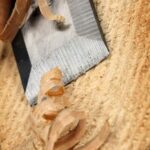Are you looking to enhance the natural beauty and durability of your woodworking projects? In this article, we will explore how to apply gel varnish woodworking, a versatile and user-friendly finish that can elevate the appearance and longevity of wood. From selecting the right wood to troubleshooting common issues, we will guide you through each step for achieving a professional-looking result.
Gel varnish is a popular choice for woodworking enthusiasts due to its ease of application and exceptional durability. It provides a thick, protective layer that enhances the natural grain of the wood while also offering resistance against scratches, stains, and moisture. Whether you are working on furniture, cabinets, or any other wooden project, gel varnish can be an excellent option for achieving a smooth and long-lasting finish.
Before diving into the application process, it’s important to understand the benefits and uses of gel varnish. We’ll discuss these aspects in detail to help you determine if gel varnish is the right choice for your woodworking project. Additionally, we will explore the different types of wood that are best suited for gel varnish application, ensuring that you achieve optimal results in terms of appearance and performance.
Selecting the Right Wood for Gel Varnish Application
When it comes to applying gel varnish in woodworking, choosing the right type of wood is crucial to achieving a successful and professional-looking finish. Different woods have different characteristics, and not all of them are suitable for gel varnish application.
One of the most important factors to consider when selecting wood for gel varnish application is the porosity of the wood. Woods with large pores, such as oak and ash, are better suited for gel varnish as they allow the product to penetrate deeply into the wood, resulting in a more durable and long-lasting finish.
On the other hand, woods with tighter grains, like maple and cherry, may require additional preparation and conditioning before applying gel varnish to ensure proper adhesion and a smooth finish.
Another consideration when choosing wood for gel varnish application is the natural color and grain pattern of the wood. Certain woods, such as mahogany and walnut, have beautiful natural colors and distinctive grain patterns that can be enhanced by gel varnish, creating a stunning visual impact on woodworking projects.
In addition to porosity and natural characteristics, it’s also important to consider the intended use of the wood project. For high-traffic areas or outdoor furniture, dense and durable woods like teak or cedar are ideal choices for gel varnish application due to their natural resistance to moisture, rot, and insects. Understanding these factors will ensure that you select the right wood for your gel varnish woodworking project.
Preparing the Wood Surface
Sanding, cleaning, and priming the wood surface are crucial steps to ensure a successful application of gel varnish in woodworking projects. Proper preparation will not only result in a smoother finish but also contribute to the longevity of the varnished wood.
First, sanding the wood surface is essential for removing any existing finish, smoothing out imperfections, and creating a good amount of friction for the varnish to adhere to. Start with a coarse-grit sandpaper and gradually progress to finer grits until the surface is smooth to the touch. Be sure to sand along the grain of the wood for best results.
Once the sanding process is complete, it is important to thoroughly clean the wood surface before applying gel varnish. Any dust or debris left on the wood can negatively impact the adhesion and appearance of the varnish. Use a tack cloth or a microfiber cloth to remove all dust particles from the surface, ensuring that it is completely clean.
After sanding and cleaning, priming may be necessary depending on the type of wood being used. Some woods are naturally porous and require a primer to seal the pores and create an even base for the gel varnish. Before applying any primer, make sure that it is compatible with gel varnish and follow manufacturer’s instructions for application.
Finally, taking extra care during these preparatory steps will ultimately contribute to a professional-looking final product when applying gel varnish in woodworking projects.
| Wood Surface Preparation Steps | Description |
|---|---|
| Sanding | Use coarse-grit sandpaper before progressing to finer grits; sand along the grain of the wood |
| Cleaning | Thoroughly remove all dust and debris using a tack cloth or microfiber cloth |
| Priming | Apply primer if necessary after ensuring compatibility with gel varnish; follow manufacturer’s instructions |
Applying Gel Varnish
Gel varnish is a popular choice for woodworkers looking to achieve a smooth and glossy finish on their projects. When applying gel varnish, there are several techniques and tips that can help ensure a professional-looking result. Whether you’re working on a small craft project or a large piece of furniture, the following tips will guide you through the process of applying gel varnish for a smooth finish.
To achieve a smooth finish when applying gel varnish to wood, consider the following techniques and tips:
- Use a high-quality synthetic brush or foam brush to apply the gel varnish. This will help minimize brush strokes and create an even coat.
- Apply the gel varnish in thin, even layers to avoid drips and bubbles. Allow each layer to dry completely before applying the next one.
- To further minimize brush strokes, consider using a foam roller or sprayer to apply the gel varnish. This can result in a more uniform finish.
- Work in a well-ventilated area to allow for proper drying and curing of the gel varnish. Avoid applying the varnish in areas with high humidity or dust, as this can affect the final finish.
Taking these techniques and tips into consideration will help you achieve a smooth and professional-looking finish when applying gel varnish to your woodworking projects.
When it comes to achieving a smooth finish with gel varnish woodworking, it’s important to take your time and follow these techniques and tips carefully. With patience and attention to detail, you can create stunning results that showcase the natural beauty of the wood while providing durable protection.
Understanding Drying and Curing Times for Gel Varnish
What Are Drying and Curing Times?
When applying gel varnish to woodworking projects, it is crucial to understand the drying and curing times to achieve the best results. Drying time refers to the period it takes for the solvents in the varnish to evaporate, leaving behind a dry surface. On the other hand, curing time involves the hardening of the varnish film, which can take much longer than drying. Understanding these times will help you plan your project timeline effectively.
Factors Affecting Drying and Curing Times
Several factors can affect the drying and curing times of gel varnish, including temperature, humidity, ventilation, and thickness of application. Warmer temperatures with low humidity levels generally lead to faster drying and curing times. Proper ventilation is also essential for allowing the solvents to evaporate efficiently. Additionally, thicker applications of gel varnish will require more time to dry and cure compared to thin coats.
Tips for Managing Drying and Curing Times
To ensure optimal results when working with gel varnish in woodworking, it is important to follow some key tips for managing drying and curing times. Firstly, always check the manufacturer’s instructions on recommended drying and curing times for the specific product you are using.
Additionally, avoid applying thick coats of varnish which can significantly extend both drying and curing times. Lastly
By understanding these factors and following these tips, you can effectively manage the drying and curing times for gel varnish when working on your woodworking projects.
Sanding and Buffing for a Professional Look
After the gel varnish has dried and cured properly, the next step in achieving a professional look for your woodworking project is to sand and buff the surface. This process helps to smooth out any imperfections, remove dust particles, and create a polished finish. Here are the steps to sanding and buffing for a professional look:
- Begin by lightly sanding the surface with fine-grit sandpaper. Use a sanding block or pad to ensure even pressure and avoid creating uneven spots on the wood.
- After sanding, wipe down the surface with a tack cloth or microfiber cloth to remove any dust particles. It is essential to have a clean surface before moving on to buffing.
- Next, apply a small amount of finishing compound or polish onto a clean, soft cloth. Work the compound into the wood in circular motions, gradually covering the entire surface.
By following these steps, you can achieve a professional, high-gloss finish that enhances the natural beauty of the wood and provides long-lasting protection.
Once you have completed the buffing process, take some time to inspect the wood surface for any remaining imperfections or uneven areas. If necessary, repeat the process of sanding and buffing until you are satisfied with the result. With careful attention to detail and patience, you can achieve an exceptional finish that showcases your woodworking skills and craftsmanship.
Remember that proper maintenance is key to preserving the beauty of gel varnished wood projects. Regular dusting and cleaning with a gentle wood cleaner will help keep your woodworking creations looking their best for years to come.
Troubleshooting Common Issues With Gel Varnish Application
Uneven Application
One common issue when applying gel varnish to wood is achieving an even application. This can result in patches of the wood having too much varnish while other areas have too little. To prevent this problem, it’s important to apply the gel varnish in thin, even coats.
Use a high-quality brush or applicator to ensure an even distribution of the varnish on the wood surface. If you notice any unevenness during application, try using a foam brush or roller to smooth out the varnish and create a uniform finish.
Air Bubbles and Brush Marks
Another issue that woodworkers may encounter when applying gel varnish is the presence of air bubbles and brush marks on the finished surface. These imperfections can detract from the overall appearance of the wood project. To avoid this problem, it’s crucial to work in a well-ventilated area with minimal dust and debris that can get trapped in the varnish.
Additionally, using a natural bristle brush instead of a synthetic one can help reduce the occurrence of brush marks. Take your time during application and use long, smooth strokes to minimize bubbles and brush marks.
Yellowing or Discoloration
Some gel varnishes have a tendency to yellow over time, which can alter the natural color of the wood and affect its overall appearance. To prevent yellowing or discoloration, it’s essential to select a high-quality, non-yellowing gel varnish specifically formulated for woodworking projects. Before applying the varnish to your wood project, test it on a small, inconspicuous area to ensure that it does not cause any unwanted discoloration over time.
Maintaining and Caring for Gel Varnished Wood Projects
Now that you have successfully applied gel varnish to your woodworking project, it is important to understand the proper maintenance and care needed to keep it looking its best for years to come. Proper maintenance can extend the life of the varnish and protect the wood beneath it, ensuring that your hard work lasts for a long time.
One key aspect of maintaining gel varnish on wood projects is regular cleaning. Dust and dirt can accumulate on the surface, dulling its shine and beauty over time. To clean gel varnished wood, simply use a soft, damp cloth to wipe away any dust or debris. Avoid using harsh chemicals or abrasive cleaners, as these can damage the varnish and wood underneath. Maintaining a regular cleaning schedule will help preserve the look of your gel varnished wood projects.
In addition to regular cleaning, it is important to protect gel varnished wood from excessive moisture and sunlight. Prolonged exposure to moisture can cause the varnish to bubble or peel, while direct sunlight can cause fading and discoloration.
To prevent these issues, consider using coasters or placemats for items placed on varnished surfaces, and use curtains or blinds to block out direct sunlight in areas where gel-varnished wood is displayed. By taking these simple precautions, you can ensure that your gel-varnished wood projects maintain their beauty for years to come.
Remember also that occasional touch-ups may be necessary over time depending on wear and tear. Knowing how to apply gel varnish woodworking techniques will allow you to easily address any minor imperfections that may occur with regular use. By following these maintenance tips, you can enjoy your gel-varnished wood projects for many years while preserving their beauty and durability.
Conclusion
In conclusion, gel varnish is a versatile and durable option for woodworking projects, offering several benefits such as easy application, excellent coverage, and a smooth finish. By following the step-by-step guidelines in this article, you can achieve professional-looking results on your wood pieces, enhancing their beauty and prolonging their lifespan.
When applying gel varnish to your woodworking projects, it’s crucial to select the right type of wood that can effectively absorb and showcase the varnish’s natural beauty. Additionally, thorough preparation of the wood surface through sanding, cleaning, and priming will ensure optimal adhesion and a flawless finish.
Understanding drying and curing times for gel varnish is essential for achieving the best results. It’s important to allow sufficient time for each coat to dry before applying subsequent layers or sanding. Utilizing proper techniques such as sanding and buffing will further enhance the aesthetic appeal of your finished project.
Frequently Asked Questions
What Is the Best Way to Apply Gel Stain to Wood?
The best way to apply gel stain to wood is to first prepare the surface by sanding it thoroughly and removing any dust. Then, using a clean brush or rag, apply a thin, even coat of gel stain in the direction of the wood grain.
Allow the stain to penetrate for a few minutes before wiping off any excess with a clean rag.
Do You Apply Gel Stain With a Brush or Rag?
Gel stain can be applied with either a brush or a rag, depending on personal preference and the size of the project. Using a brush allows for more control over the application, while using a rag can create a softer, more blended finish.
Whichever method is chosen, it’s important to apply the gel stain in thin, even coats and wipe off any excess for a smooth finish.
How Do You Apply Gel Top Coat to Wood?
To apply gel top coat to wood, start by ensuring that the stained wood is completely dry. Using a clean brush or cloth, apply a thin layer of gel top coat in long, even strokes along the wood grain.
Allow the top coat to dry according to the manufacturer’s instructions before sanding lightly with fine-grit sandpaper and applying additional coats if desired for added protection and durability.

Hi everyone! I’m a woodworker and blogger, and this is my woodworking blog. In my blog, I share tips and tricks for woodworkers of all skill levels, as well as project ideas that you can try yourself.





